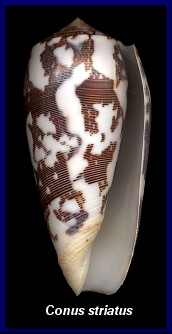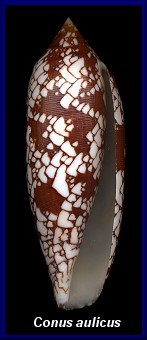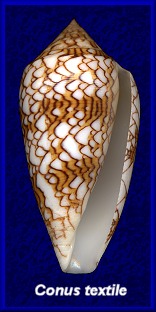| - Part Three - |
| Mollusks And Man - A Medical Perspective |
| By Harry G. Lee, M.D. |
 In the preceding two
installments, we treated medical problems involving infections
and intoxications (biotoxins) brought to man through the agency
of mollusks. This final essay will deal, in the main, with
envenomation by mollusks. First, however, we must consider a
category of illness I failed to anticipate in my original outline. In the preceding two
installments, we treated medical problems involving infections
and intoxications (biotoxins) brought to man through the agency
of mollusks. This final essay will deal, in the main, with
envenomation by mollusks. First, however, we must consider a
category of illness I failed to anticipate in my original outline.The intoxications described in installment two were all ultimately of biological origin (P.S.P., etc.). There is another form of poisoning transmitted via mollusks, particularly filter-feeding bivalves; it involves non-biological chemicals. From 1953 to 1960, a series of outbreaks of severe and somewhat bizarre neurological disease occurred in residents of the Minamata region of Japan. Epidemiologists determined that each sufferer had eaten substantial amounts of fish and/or shellfish (mollusk and/or crustacean) harvested in Minamata Bay. Effluent had been discharged by local chemical industries into the bay since 1950. Scientists were able to reproduce the illness by feeding Minamata shellfish to lab animals, and tissue mercury levels corresponded with the severity of the animals' symptoms. As discussed in both installments one and two, the poisonous shellfish had concentrated the toxic mercury. Most victims became ill gradually and manifested numbness, spastic paralysis, and bizarre automatic movements. About one-third of the patients died of the illness - most due to complicating infection and malnutrition. Needless to say, this catastrophe led to a high-profile toxic waste "clean-up" and stands as a stark example of the tenuous ecology human beings have generated for themselves and cohabiting biota. Venom is employed by diverse and myriad living creatures, but one of the most spectacular groups of venomous organisms, the members of the molluscan super family Conoidea, especially species of Conus (s.l.), are distinguished by their beauty and masterful feeding technique. We now know that cones harpoon their prey with a highly specialized radular tooth. This tooth is single, barbed, and hollow (to allow pumping of venom into the flesh after penetration of the target - normally the prey). Yet we came to this knowledge by first taking measure of the unnatural envenomation of human victims. A century and half ago, Arthur Adams and Lovell Reeve reported a painful sting inflicted on a Moluccan fisherman by Conus aulicus. A few years later, another famous British malacologist, J. E. Gray, first illustrated and described the "unique" radula of Conus. (He used this character to partition Cones into the sub-order Toxifera; today this is the equivalent of a superfamily, which fact endorses Gray's fine sense of taxonomy.) MacGillivray, writing in 1860, reported two Conus textile stings, one the first-reported fatality. A century later, the literature contained accounts of over 28 stings, 8 or more of them being fatal. Of the latter, two were attributed to C. textile, one to C. striatus, and the remainder to C. geographus.
It is important to remember that a Cone's proboscis is extensible - meaning it can reach outward - often like lightning and to a distance twice the length of the shell. Thus the "strike" of a Conus is like that of a cobra or rattlesnake. A corollary of this observation is there is no safe way to directly handle a living Conus to avoid a sting. It is unknown how thick a glove fabric is necessary in order to prevent penetration. Species which feed on fish are, as one would expect on phylogenetic grounds, the most likely to harm humans (the molluscivorous C. textile is an important exception). Fish-eaters such as Conus geographus usually have wider anterior apertures to accommodate large, less flexible prey. All cephalopods have rigid, sharp parrot-like beaks, and many have venomous saliva. Some are not indisposed to biting humans. Human octopus bites were described beginning in 1802. By 1879 the toxic effect of octopus venom was appreciated. While most cephalopods impart little more than a painful, occasionally bloody wound, there is a species of Australian octopus which has claimed at least one human life, the ten centimeter Octopus maculosus Hoyle, and its relatives, should be considered equally capable of doing so.
Mollusks lack nematocysts but have recruited and put them to use in at least two ways which I am tempted to call "ingenious". Young octopi (Tremoctopus violaceus Della Chiaje) have been observed to pick up Portuguese Man-O-War (Physalia) tentacles and hold them in their own. This form of primitive weaponry is observed as an effective defense and offense and stands as a unique example of tool use by an invertebrate. A more subtle theft of nematocysts is, however, perpetrated by the pelagic nudibranch Glaucus atlanticus Forster, 1777, which ingests Physalia tentacles, somehow lulling the nematocysts into atony, absorbs, and later deploys them near the surface of its integument. Once in place, the nematocyst has sworn fealty to its new parent organism and will discharge through the skin of the snail when the latter is disturbed. The impact on a nosy predator or an unsuspecting mollusk-collector is instant pain - and possibly a serious allergic reaction. One final vignette - that of the Sea Butterfly Creseis acicula (Rang, 1828). In 1960 an outbreak of "stings" among bathers was associated with the adhesion of numerous, inch-long Needle Pteropods to their skin and bathing suits. This "attack" occurred at St. Pete Beach! It is unknown if venom or just the needle-like shell accounted for the "stings". Before the conclusion of this survey, it seems proper to restore some balance to the medical mollusk-man interaction. As with a number of phylogenetically diverse organisms, mollusks hold potential as sources for anti-cancer drugs. Psychiatrists have told us of the salutary effects of shell study. For millions on this planet, mollusks provide critical nutrients such as iodine, calcium, and protein to name a few. And consider the potential benefits to human health that work like Dr. Olivera's will bring: treatment for neurological and cardiovascular diseases. On balance, an informed and prudent member of our species has more to gain than lose from consorting with mollusks - even when health is the sole consideration. |
 The biochemistry and pathophysiology of Conus
venom is a hot research topic in contemporary toxicology. One of
our fellow conchologists, Dr. Baldomero Olivera, while wearing
his other hat as a Cal Tech-trained biochemist, has become a
leader in the study of the composition and mode of action of cone
venom. The benchmark journal Science
cited Dr. Olivera's report on Conus
neuropeptides as its "cover story" on July 20, 1990.
The cover was a close-up color photo of the pattern of C.
textile. Through this study and several
others by Olivera and his colleagues, we have learned that the
venoms are variable mixtures of 10 to 30 amino acid-long peptides
- dozens of them in a single species' venom. These venoms are
quite prey-specific - the unfortunates ranging from mollusk to
annelid to fish. Each cone species seems to have its own recipe
of peptides in a brew that usually paralyzes but occasionally
agitates suitable prey. All are potent neurotoxins, and the way
they operate on a molecular level has already led to a better
understanding of the normal
function of cell membranes and neurochemical transmission.
The biochemistry and pathophysiology of Conus
venom is a hot research topic in contemporary toxicology. One of
our fellow conchologists, Dr. Baldomero Olivera, while wearing
his other hat as a Cal Tech-trained biochemist, has become a
leader in the study of the composition and mode of action of cone
venom. The benchmark journal Science
cited Dr. Olivera's report on Conus
neuropeptides as its "cover story" on July 20, 1990.
The cover was a close-up color photo of the pattern of C.
textile. Through this study and several
others by Olivera and his colleagues, we have learned that the
venoms are variable mixtures of 10 to 30 amino acid-long peptides
- dozens of them in a single species' venom. These venoms are
quite prey-specific - the unfortunates ranging from mollusk to
annelid to fish. Each cone species seems to have its own recipe
of peptides in a brew that usually paralyzes but occasionally
agitates suitable prey. All are potent neurotoxins, and the way
they operate on a molecular level has already led to a better
understanding of the normal
function of cell membranes and neurochemical transmission. Readers are certainly
familiar, often by first hand experience, with the nettlesome (or
worse) effects of coelenterates such as jellyfish. These stinging
creatures depend on specialized structures called nematocysts
which inject venom into prey (etc.) under appropriate stimuli.
Readers are certainly
familiar, often by first hand experience, with the nettlesome (or
worse) effects of coelenterates such as jellyfish. These stinging
creatures depend on specialized structures called nematocysts
which inject venom into prey (etc.) under appropriate stimuli.